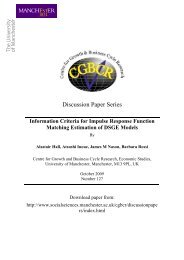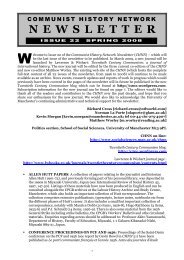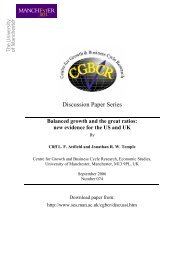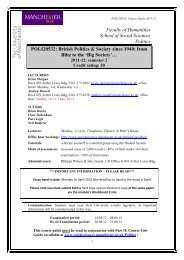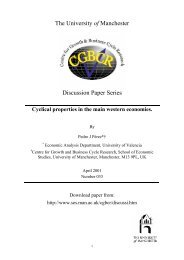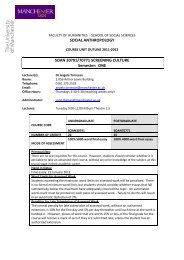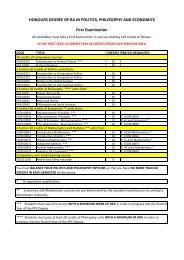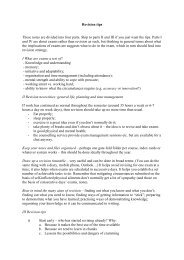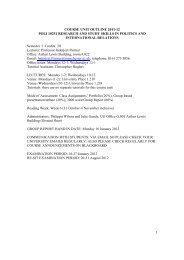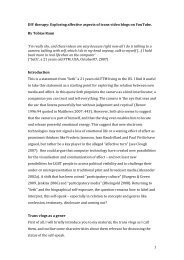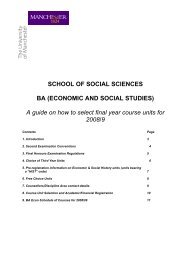second year course outlines 2012-2013 - School of Social Sciences ...
second year course outlines 2012-2013 - School of Social Sciences ...
second year course outlines 2012-2013 - School of Social Sciences ...
You also want an ePaper? Increase the reach of your titles
YUMPU automatically turns print PDFs into web optimized ePapers that Google loves.
Students should consult the University’s statement on plagiarism which can be obtained<br />
from the <strong>School</strong> <strong>of</strong> <strong>Social</strong> <strong>Sciences</strong> student intranet.<br />
There are a number <strong>of</strong> referencing systems available. One that is both simple and widely<br />
used is the Harvard system <strong>of</strong> referencing. On this system, the bibliography would be set out<br />
as follows:<br />
Putnam, Hilary (1975) ‘The Meaning <strong>of</strong> ‘Meaning’’ in his Philosophical Papers volume II<br />
(Cambridge, UK: Cambridge University Press), pp.105-219.<br />
Quine, W.V.O. (1960) Word and Object (Cambridge, Massachusetts: MIT Press).<br />
Ryle, Gilbert (1948) ‘It Was to Be’ Mind 47 pp.23-38.<br />
The system <strong>of</strong> referencing, then, has this pattern:<br />
Or:<br />
Surname, first name, date, title <strong>of</strong> book, location <strong>of</strong> publisher, name <strong>of</strong> publisher.<br />
Surname, first name, date, title <strong>of</strong> article, title <strong>of</strong> journal or collection, journal volume<br />
number, page numbers for the beginning and end <strong>of</strong> the article.<br />
Note that the title <strong>of</strong> the book or the journal should be italicised (or underlined.) The title <strong>of</strong> an<br />
article should be in quote-marks. (See the examples <strong>of</strong> Putnam and Ryle above.)<br />
If the bibliography contains more than one item by an author published in the same <strong>year</strong>, the<br />
convention is to write the date followed by a small case letter. For example, (1948a), (1948b),<br />
etc.<br />
Whenever you make a claim about what a philosopher says or believes – whether in direct<br />
or indirect speech – you must back it up with a reference. When giving a reference in your<br />
essay, simply write the author’s name, followed by the date, followed by the relevant page(s).<br />
The convention is to put the reference at the end <strong>of</strong> a sentence. For example:<br />
Ryle thought that the word ‘exists’ is ambiguous (Ryle (1949) pp.23-24). Quine<br />
argued against Ryle’s view (Quine (1960) p.61).<br />
Note that page numbers are given. Not including page references is very poor page<br />
referencing. The point <strong>of</strong> giving page references is to support your claim that Ryle or Quine<br />
say what you claim they said. The reader can check for him or herself that these<br />
philosophers said what you claimed they said without having to thumb through every page <strong>of</strong><br />
the relevant books.<br />
For further details please see the referencing guide included in the Philosophy Study Guide.<br />
Handing in your essay<br />
Two copies <strong>of</strong> your essay should be handed to the SoSS Undergraduate Office, G.001, in<br />
the Arthur Lewis Building.<br />
You must also submit your essay electronically to ‘Turnitin’ via Blackboard. Further<br />
instructions on this will be made available on the Blackboard site for the <strong>course</strong>, see:<br />
https://login.manchester.ac.uk/cas/login<br />
83



